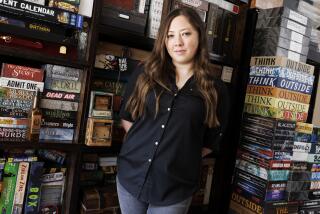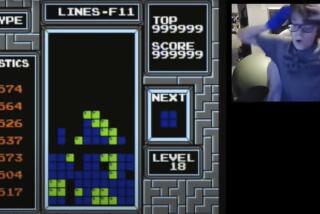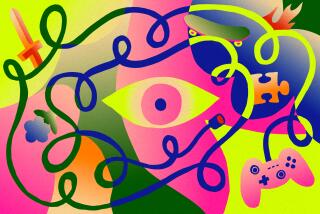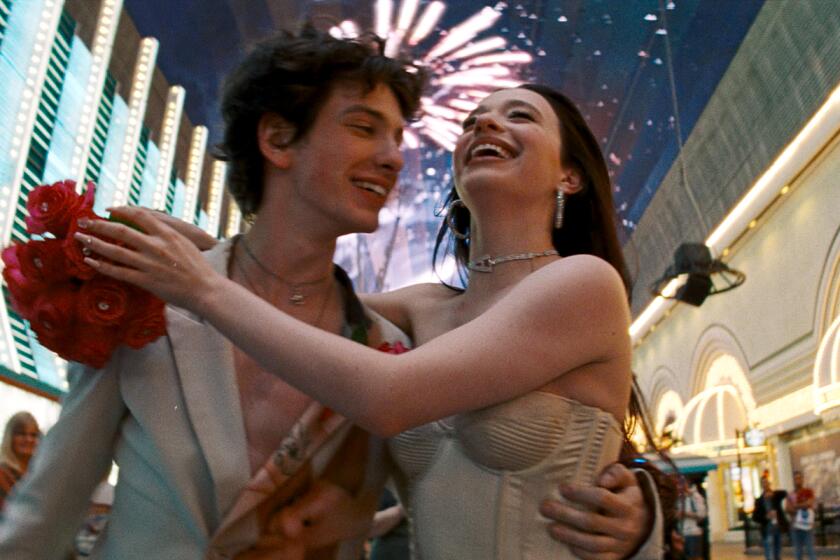The Player: Can’t crack ‘The Witness’? Part of the fun is in the mystery, not just the answers
- Share via
Draw a line. It sounds simple, doesn’t it?
“The Witness,” from a sort of zoned-out satellite view, is a game about drawing lines. To be even more precise, it is a game populated with puzzles, the bulk of them solved by drawing a line. Again, it all sounds so simple.
Yet “The Witness” just so happens to be the rare puzzle game that’s less about answers and more about mysteries and epiphanies.
“The Witness” is a game that uses its pastoral atmosphere to sooth and relax, casually laying dastardly complex brainteasers before the player. All of them are placed in a colorful, warm and surprisingly optimistic universe. The landscapes here may be devoid of human life, but these are interactive grounds built for a picnic — the look of some alien, once-utopian world.
The game’s setting is that of a lush and vividly colored island. Pink and purple flora sprout around majestic castles, ancient temples and small towns. It’s gorgeous and full of familiar but curious objects.
Statues of men and women appear frozen in time. Sometimes they’re accompanied with laptops. Sometimes they’re posed in the stance of a grand orator. These people — or are they sculptures? — appear caught midaction. What happened to the population of the island is the great conundrum at the heart of “The Witness.”
This backdrop, one that’s enticing, magical and quiet, will no doubt bring to mind the classic puzzle exploration title “Myst.” It is just part of what makes “The Witness” so special. For this is a puzzle game that beguiles the player not just with challenges but a sense of adventure.
So while all that “The Witness” asks of the player is that the participant be able to draw a line, such a request comes off as an invitation. As the trials get tougher — and “The Witness” gets awfully difficult awfully quick — it may even feel like a tease. But it’s never a trick.
“The Witness” was developed by a small team led by Jonathan Blow, an independent game designer best known for the vexing time-bending game “Braid,” one of the first breakout hits of the independent era. Blow was a star in 2012’s Sundance success story “Indie Game: The Movie,” and “Braid’s” success has made “The Witness,” available now for the PlayStation 4 and PCs, one of the first highly anticipated games of 2016.
Each correct solution offers but a small peek into a handcrafted tropical universe. At times, it creates the sensation of stepping into a wondrous psychological experiment. It’s as if the island is alive and analyzing the personality of the player.
How, for example, do you interpret the meaning of two yellow blocks on a grid? What about a frame with a red arrow? Or one with a tree blossoming in its center?
Move forward, the game beckons. Try to uncover our secrets, it seems to be saying. Chances are the game will be smarter than you. It is smarter than me.
But “The Witness” isn’t out to fool you. It just wants you to think about shapes and figures and lines as if they’re ideas — a long-lost language, perhaps, just waiting for someone ardent enough to crack it.
I’m a dozen-plus hours into “The Witness,” and the bulk of its puzzles remain unsolved. Yet I don’t have the sense of failing or simply coming up with the wrong answer. No, “The Witness” has made me feel as if there’s another way to see the world. I just haven’t fully come around to the game’s point of view yet.
The town at the feet of a windmill? I can’t begin to tell you how to enter any of its buildings. The trail to the top of the mountain? I’m sure I’m missing something among all those nooks and crannies amid the forest, perhaps another Albert Einstein audio recording.
None of that matters. I’ve already read that there are people who have completed “The Witness.” I’m slightly jealous of their intellect. Or maybe I’m not. After all, I’m not so sure this is a game I want to be able to power through in a weekend. I like knowing that “The Witness” remains unsolved, that its puzzles and questions are in need of a closer study.
It’s a game built for patient contemplation, and playing it, especially when it’s at its most arduous, reminds me of learning Spanish in high school. That is, it’s taxing and difficult, but understanding it appears to unlock a whole new way of thinking.
And what a joy it is to find a solution.
Some puzzles are as simple as isolating different shapes or colors. Others require the careful review of the nearby environment and can be solved by a shift in perspective or a reflection of the sun. Each builds upon what the player has learned before, subtly adding new elements so that every individual test feels fresh.
When completed, neon tubes light up, essentially “turning on” the island, which then leads to the next puzzle. Some serve as a beacon pointing the way to a mountain. One even created a boat to make it easier to traverse the lands. They’re all more or less presented on futuristic-looking panels that are unlocked by drawing the correct path for a maze.
It’s all a bit abstruse and ambient, and “The Witness” feels less about creating a grand conclusion than simply creating an environment in which one can be pondered. It took only a matter of minutes, for instance, for “The Witness” to make me forget it all started by drawing a line.
Twitter: @Toddmartens
More to Read
The biggest entertainment stories
Get our big stories about Hollywood, film, television, music, arts, culture and more right in your inbox as soon as they publish.
You may occasionally receive promotional content from the Los Angeles Times.











